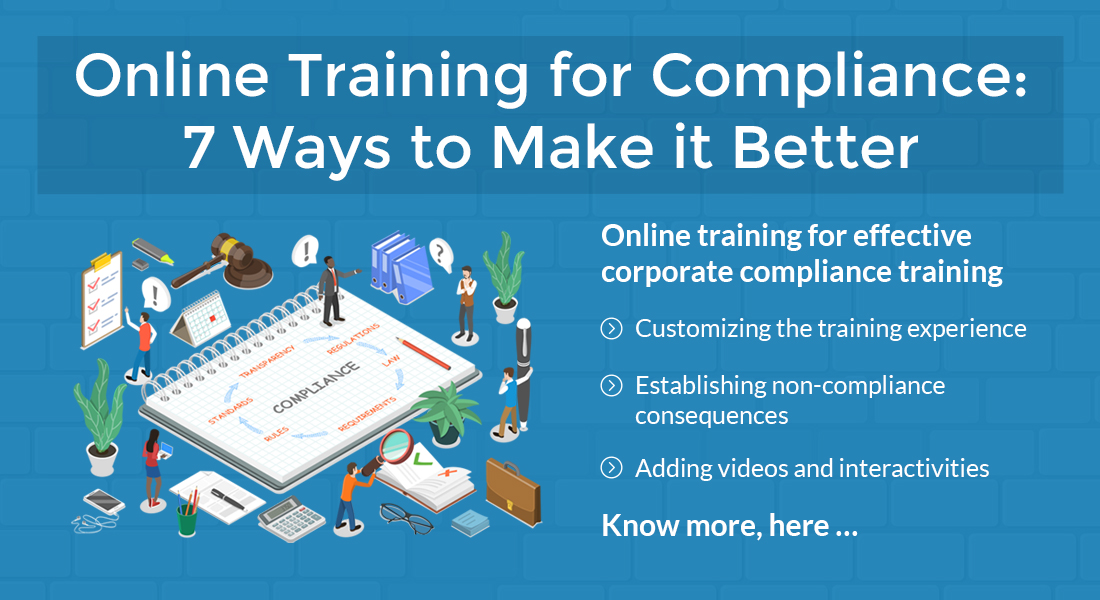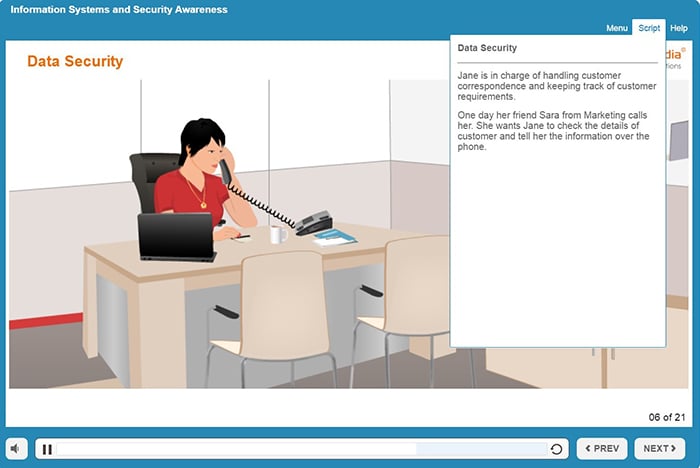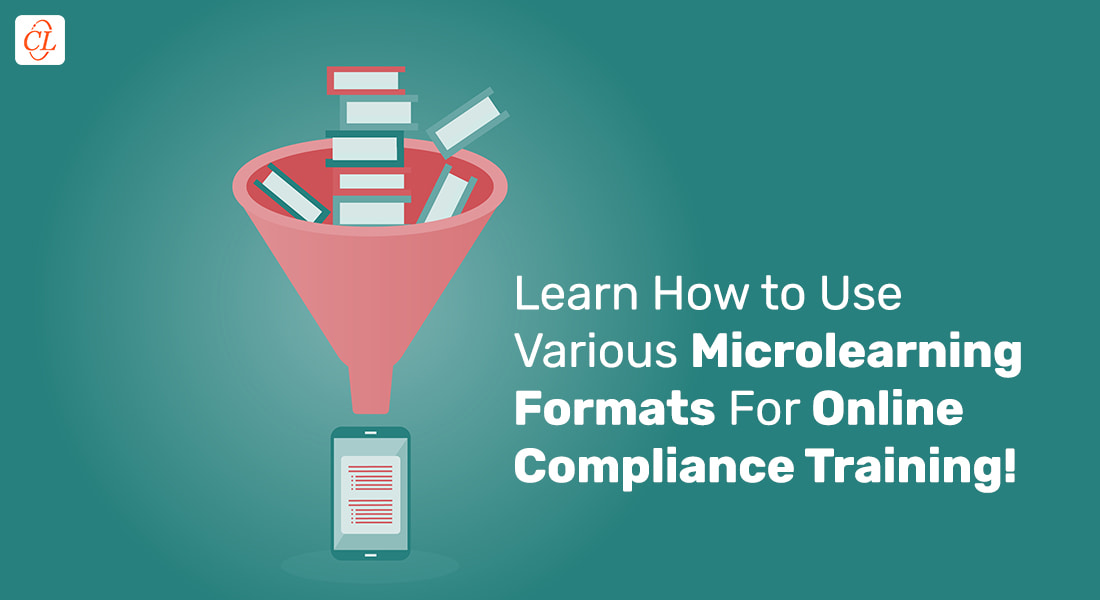How to Use Online Training for Effective Compliance Training

Compliance training is an important part of training in most if not all businesses today. Not only is it mandated by law, but it is also critical to maintain safety and ethics in the workplace. Non-compliance can lead to serious consequences including fines, penalties, and injuries. Thanks to COVID-19, as online training has become the norm for corporate training, organizations are bound by law to provide online compliance training to their employees. But how effective is online training for compliance training?
Online Compliance Training – 7 Steps to Better Engagement
- Customize compliance training according to learners
- Include elements of storytelling
- Real-life situations
- Fictional scenarios
- Relatable characters
- Show the consequences of non-compliance
- Provide multi-device access to courses
- Use videos and interactivities
- Use microlearning nuggets
- Use gamification elements
→ Wondering how to use mobile learning for beating training woes? Download this webinar NOW.
This blog gives you an overview of compliance training, its importance to organizations, and the peculiarities of compliance training that make it a different ball game from other types of employee training. It then discusses some tips for effective compliance training, that if implemented, will make all the difference between compliance and non-compliance.
Why is Compliance Training Important?
Corporate compliance training is legally mandated training that aims to keep corporate employees informed on workplace safety, legal and ethical requirements they are needed to follow. Here are a few examples.
- Workplace Safety training
- Prevention of Sexual Harassment training (POSH)
- Ethics and Code of Conduct training
- Workplace Diversity training
- Information Security training
The objective of compliance training is a safe, healthy, and productive working environment for all employees. The training aims to help employees understand appropriate behaviors for different situations they may be placed in. Compliance training helps:
- Reduce the number of workplace injuries (safety training)
- Avoid potentially damaging lawsuits (regulatory training)
- Prevent physical, verbal, sexual and mental abuse in the workplace (POSH training)
- Build a more inclusive culture (diversity training)
Compliance Training vs. Other Types of Training
Compliance training is quite different from other types of training. Understanding these differences will help you create more effective compliance training programs.
It is a mandatory requirement
Given that compliance training maintains workplace safety and protects organizations against regulatory breaches, it is a legal requirement that learners undergo this training. So, unlike other forms of training like sales or product, which are employee-specific and conducted only when needed, compliance courses are for all employees.
It needs to be taken regularly
Unlike other employee-specific elective corporate training, compliance training is required to be done annually (usually). Which means all employees are required to undergo compliance training as well as its refresher once every year.
It’s worth must be established
Unlike skills training (or other types of training where the employee can get the ‘What’s in it for me?’), the benefits of compliance training are not immediately apparent to learners. For example, they will not be as interested in a course on workplace diversity as in a course on MS Excel. So, its value must be established – what diversity training ensures and what it protects. You need to think very creatively to show them the ‘What’s in it for them’ with compliance training.
Requirements may be location or state specific
Different states and different countries have different laws and regulations, which affect the kind of compliance training provided. So, a diversity or POSH training for a global company located in the Middle East will be different from its American or Canadian counterparts. To ensure compliance, you will need to tailor the training according to the different requirements.
Wouldn’t it be great if your learners were interested and engaged with the compliance training instead of finding it another tedious mandatory course to complete?

How L&D And Business Can Align to Conquer The Future Of Work
Bridging the Gap Between Organizational and Individual Goals!
- Learning Strategies Shaping the Future
- Changing Role of Learning Professionals
- Learning to Solve Business Challenges
- And More!
7 Best Practices for Better Compliance Training
Let’s take a look at the seven practices one can follow to improve online compliance training.
1. Customize Training According to Learners
Customize the content and delivery method of the compliance training program according to the audience to make the training more effective.
Customizing compliance courses ensures different courses for employees at different organizational levels. For instance, training on prevention of sexual harassment or diversity and inclusion is required for all employees, but a course on cybersecurity may be important only for the network and IT teams, and not for other departments with white collar workers.
2. Include Storytelling in Compliance Training
Instead of providing a lot of compliance documents for the learner to read through, convert the content into situations that employees might actually face while performing their jobs. Storytelling in eLearning is an excellent strategy to gain learner attention, interest, and motivation. You can include storytelling elements in compliance training through:
Real-life situations: Explaining a complicated compliance issue through specific situations with real-life examples can help learners understand the situation better and help put things in context.
Scenarios and narratives: As useful as real-life situations are, using fictional stories with the issues happening to someone else will make the situations memorable and help with scenario-based learning.
Relatable characters and avatars: A good story needs a good hero/villain. Having a character or avatar in the stories that the learner can relate to, adds to the emotional impact of the compliance training. The character can also be used to show the consequences of non-compliance.

Remember to keep the narratives and scenarios culturally significant and relatable. There are cultural barriers in instructional design that pop up when developing a course for global audience. Know your learner demographic beforehand to avoid those.
3. Establish Consequences of Non-compliance
Failing to comply with rules can have disastrous consequences. Learners need to be made aware of what will happen if they don’t follow what is specified in the compliance training program.
Training on topics such as workplace safety, information security, and prevention of sexual harassment can be used to demonstrate the consequences of failure through videos, click-to-perform interactive infographics and scenarios.
4. Provide Access through Multiple Devices
One of the chief drawbacks of compliance training is that learners get disengaged very fast.
However, it will help if you allow learners to access the training on the device of their choice (desktops, smartphones and/or tablets). Mobile learning is a great way of motivating learners to complete the training.
5. Add Engaging Videos and Interactivities
Videos are a great resource in compliance training, and can be very effective in helping learners retain information. You can use videos to:
- Simplify and break down complicated concepts
- Explain the consequences of non-compliance
Interactivities in eLearning courses are also great engagement tools. Adding interactive media elements in compliance training can give a clearer idea of situations and what to do in them.
6. Provide Small Microlearning Doses
Learners tend to forget most of the information they learned in less than a day. That is why it makes sense not to overload learners with a lot of information they don’t need. You can use microlearning modules to provide concise essential information in small nuggets that can be completed in minutes.
7. Gamify Compliance Training
Compliance training is usually a very boring tedious affair. Alleviate boredom and increase fun and engagement by adding game elements to training – skill points, rewards, level-ups, leaderboards, and rankings.
You can add milestones and rewards at specific points in the compliance training. Plus, you can also use microlearning modules as training resources and as level-ups or skill points that can be displayed on the learning management system.
Whisper in the Wind !
Have you heard of blended learning? It’s a training method that combines two or more different strategies (both synchronous and asynchronous). Blended learning has shown to be very effective especially because learners can reap the benefits of different training methods. This can also be beneficial for compliance training.
Learners doing mandatory compliance training remotely, might not be able to attend the sessions always whenever they are scheduled. For them, blending synchronous VILT sessions with asynchronous eLearning modules will be a better alternative, simply because they can choose how to learn based on their own preference.
Wrapping Up!
So here we are, at the end. Do you think you now have a little more clarity on how to make online compliance training better? It’s really not rocket science, but it’s an integral part of corporate training nonetheless. You MUST ensure that compliance training is top notch, otherwise the consequences in terms of business results might be quite serious.
If you are concerned about such a major change in your organization’s corporate compliance training, you can outsource course design and development to an eLearning vendor. They specialize in shifting training from the classroom to eLearning, among a lot of other services.
Before I take my leave, let me give you a handy eBook that will help you make a business case for eLearning to your boss.





